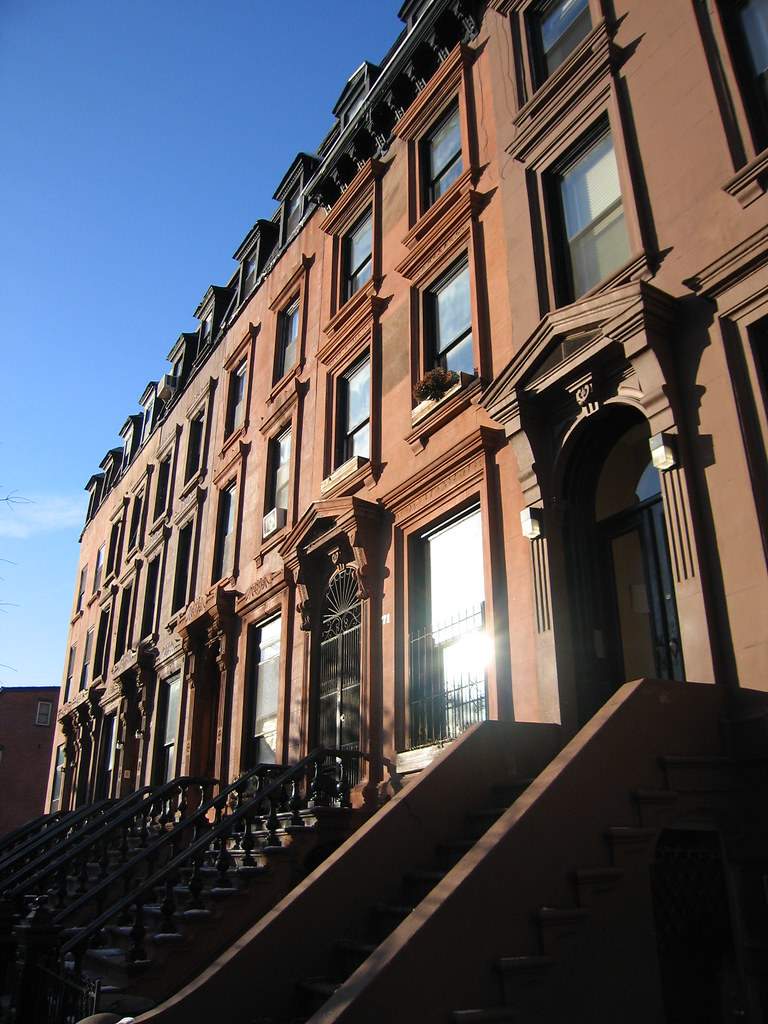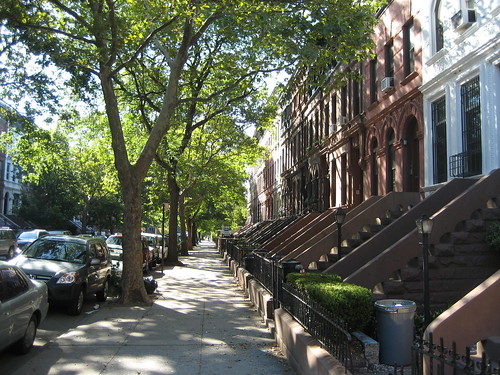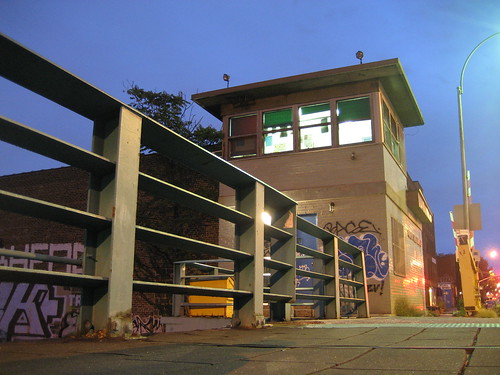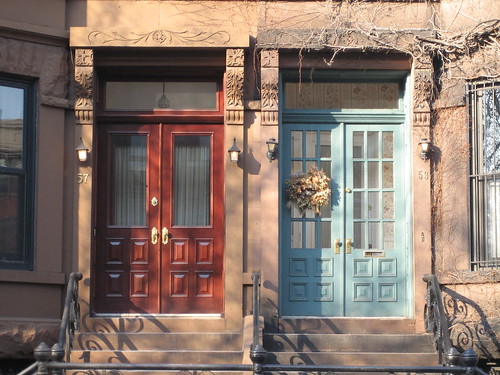brownstone brooklyn
Architecturally, there are a few different Brooklyns. In Williamsburg, Greenpoint, and Bushwick, industrial forms dominate the urban landscape. In some east Brooklyn neighborhoods, charming single-family homes contribute to a character that can feel a little bit more 'Long Island' than 'New York'.
 Park Slope Sunset
Park Slope Sunset
Growing up in New England, my first impressions of Brooklyn came from the Cosby show. Perhaps that's why today, no building says 'Brooklyn' to me like the Brownstone.
 Clinton Hill afternoon
Clinton Hill afternoon
Following the completion of the Brooklyn Bridge in 1883, there was a construction boom of three-to-five-story row houses to accommodate the burgeoning commuter population. Barged in from quarries in New Jersey and the Connecticut River Valley, brownstone was carried directly up Brooklyn's Gowanus Canal and then carted to nearby areas. Accordingly, the neighborhoods surrounding the canal (like Carrol Gardens, Park Slope, and Fort Greene) are of a remarkably consistent scale and style. This is Brownstone Brooklyn.
 Prospect Heights morning
Prospect Heights morning
Ironically, some of the most interesting spots in Brownstone Brooklyn are the places where the ubiquitous row houses are absent. One of these is the Gowanus Canal itself. Odious noises and smells from industry has discouraged residential development over the years, but things could change soon. Declining urban industry, the waning of the aforementioned odor, and increasing land values suggest things will not stay the same.
Developers have been snapping up properties in the area along the canal for years now, but it's still unclear just what sort of development will take place. While it once seemed that the large scale development of the area was inevitable, lingering environmental issues and a lack of public transportation have slowed the process. Gowanus Lounge blog even doubts whether the famous (infamous?) Gowanus Whole Foods will ever get built.
 Union Street drawbridge
Union Street drawbridge
Gowanus has a number of cool old buildings and some really great bridges. The Carroll Street Bridge is one of the only remaining retractile bridges in the country and the monolithic steel viaduct at 9th Street is the highest point in the New York City subway system. It's even home to the Empty Vessel Project, a fascinating seaborne community arts experiment. Very few Brownstones, though.
Looking ahead, it's tough to imagine that Brownstone Brooklyn will remain unchanged as it heads deeper into the 21st Century. While the skyrocketing prices of brownstones in neighborhoods like Prospect Heights and South Park Slope should discourage the demolition of existing buildings (landmarking or contextual zoning laws protect buildings in some areas as well,) there are very few new rowhouses (of any material) being built. It is particularly unlikely that areas with lots of development potential -- Gowanus and the areas around Atlantic Yards, for example -- will be developed as low-rise housing given the market conditions.
 Park Slope doors
Park Slope doors
Despite my love of brownstones, I don't think the introduction of new forms to Brooklyn is necessarily a bad thing. The brownstone emerged as a dominant style because of economic forces in the 1880s and 1890s, not because everyone thought it would be cool to build matching row houses. Working within the existing context, developers can produce structures that fit into Brooklyn's contemporary economy with a modern design vernacular. This means the area may change somewhat in appearance, but the underlying middle-class character can survive. The dangers lie at the extremes: preventing new development will cause prices to rise, turning Brownstone Brooklyn into an enclave for the wealthy; developments that ignore the existing context can interfere with the streetscape and diminish what made the area so wonderful in the first place.
Debates over development tend to be polarizing -- the best solutions usually lie somewhere in the middle. Hopefully, Brownstone Brooklyn can balance preservation with innovation as it grows into the 21st century.
 Park Slope Sunset
Park Slope SunsetGrowing up in New England, my first impressions of Brooklyn came from the Cosby show. Perhaps that's why today, no building says 'Brooklyn' to me like the Brownstone.
 Clinton Hill afternoon
Clinton Hill afternoonFollowing the completion of the Brooklyn Bridge in 1883, there was a construction boom of three-to-five-story row houses to accommodate the burgeoning commuter population. Barged in from quarries in New Jersey and the Connecticut River Valley, brownstone was carried directly up Brooklyn's Gowanus Canal and then carted to nearby areas. Accordingly, the neighborhoods surrounding the canal (like Carrol Gardens, Park Slope, and Fort Greene) are of a remarkably consistent scale and style. This is Brownstone Brooklyn.
 Prospect Heights morning
Prospect Heights morningIronically, some of the most interesting spots in Brownstone Brooklyn are the places where the ubiquitous row houses are absent. One of these is the Gowanus Canal itself. Odious noises and smells from industry has discouraged residential development over the years, but things could change soon. Declining urban industry, the waning of the aforementioned odor, and increasing land values suggest things will not stay the same.
Developers have been snapping up properties in the area along the canal for years now, but it's still unclear just what sort of development will take place. While it once seemed that the large scale development of the area was inevitable, lingering environmental issues and a lack of public transportation have slowed the process. Gowanus Lounge blog even doubts whether the famous (infamous?) Gowanus Whole Foods will ever get built.
 Union Street drawbridge
Union Street drawbridgeGowanus has a number of cool old buildings and some really great bridges. The Carroll Street Bridge is one of the only remaining retractile bridges in the country and the monolithic steel viaduct at 9th Street is the highest point in the New York City subway system. It's even home to the Empty Vessel Project, a fascinating seaborne community arts experiment. Very few Brownstones, though.
Looking ahead, it's tough to imagine that Brownstone Brooklyn will remain unchanged as it heads deeper into the 21st Century. While the skyrocketing prices of brownstones in neighborhoods like Prospect Heights and South Park Slope should discourage the demolition of existing buildings (landmarking or contextual zoning laws protect buildings in some areas as well,) there are very few new rowhouses (of any material) being built. It is particularly unlikely that areas with lots of development potential -- Gowanus and the areas around Atlantic Yards, for example -- will be developed as low-rise housing given the market conditions.
 Park Slope doors
Park Slope doorsDespite my love of brownstones, I don't think the introduction of new forms to Brooklyn is necessarily a bad thing. The brownstone emerged as a dominant style because of economic forces in the 1880s and 1890s, not because everyone thought it would be cool to build matching row houses. Working within the existing context, developers can produce structures that fit into Brooklyn's contemporary economy with a modern design vernacular. This means the area may change somewhat in appearance, but the underlying middle-class character can survive. The dangers lie at the extremes: preventing new development will cause prices to rise, turning Brownstone Brooklyn into an enclave for the wealthy; developments that ignore the existing context can interfere with the streetscape and diminish what made the area so wonderful in the first place.
Debates over development tend to be polarizing -- the best solutions usually lie somewhere in the middle. Hopefully, Brownstone Brooklyn can balance preservation with innovation as it grows into the 21st century.

9 comments:
If by "one of only remaining rail-mounted swing bridges in the country" you mean a retractile bridge (a retractile bridge slides along a track to allow the bridge to move and ships to pass), then you are referring to the Carroll Street bridge, not Third Street. The Third Street Bridge is, according to NYDOT, a double-leaf Scherzer rolling lift bascule bridge, or a drawbridge that rolls on a track.
Whoops, you're absolutely right. Good catch, thanks! (I wouldn't want to offend any double-leaf Scherzer rolling lift bascule bridges...)
I was going to correct that, but someone beat me to it...
I'm anonymous 10/4/2006, 2:40 PM. I only wrote in the correction because the Carroll St. Bridge is one of my favorite things in New York. Full stop. The rest of the bridge info comes from google, not some overwrought bridge enthusiasm.
Nice blog, BTW.
It is a wonderful bridge -- I've never had the chance to see it in operation, though. As embarassed as I was to misidentify one of my favorite Gowanus landmarks, I was pleased to discover how knowledgeable my readers are.
Another one of my favorite draw bridges is in Providence, Rhode Island. http://flickr.com/photos/sonjashield/170144114/ The 'Red Bridge' over the Seekonk River has been permanently locked in the up position since the 60s -- a bizarre landmark.
Thanks for reading!
I never knew the brownstone was brought down from the north. I guess thats why all the sections near the river have more brownstones. Interesting article! Got me thinking especially since I am looking to move into the area.
Post a Comment